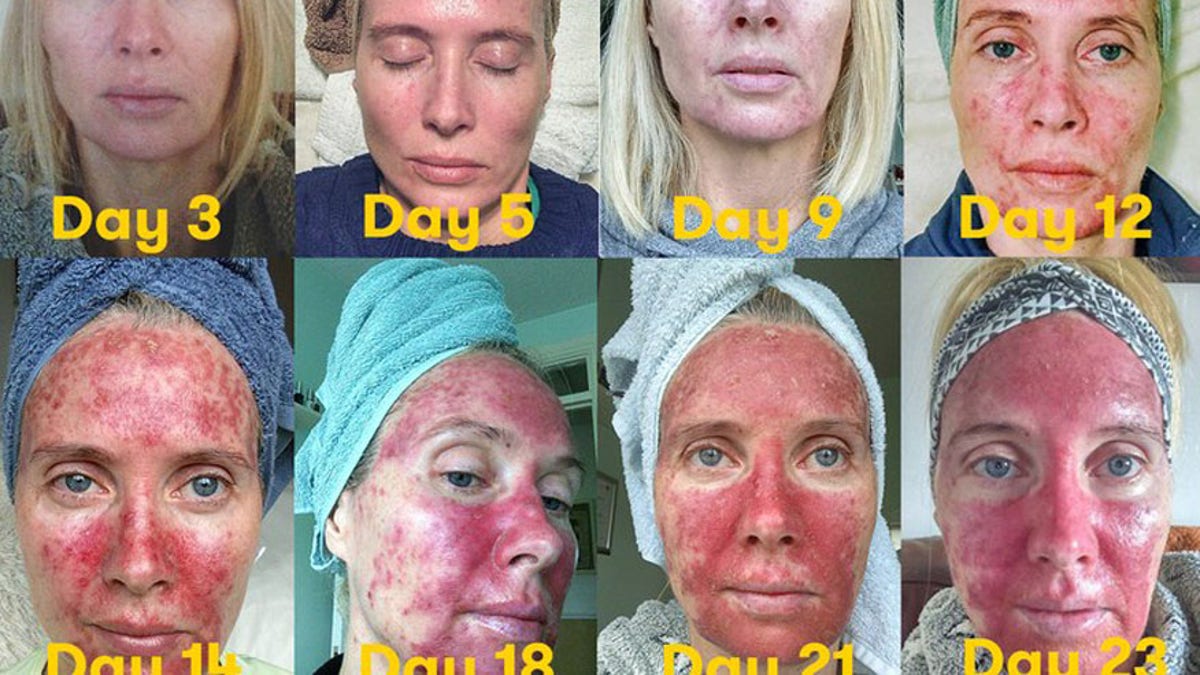
Mags Murphy, 45, of Dublin, Ireland, grew up loving the sun. She wrote on Facebook that she "spent over a decade living in Crete tanning myself to 'look good,'" she "spent summers doing tanning beds just for a tan in the shitty Irish weather," and as a child she'd run around outside without wearing any sunscreen. But now, Murphy is paying the price for her love of looking tan. She was recently diagnosed with precancerous skin cancer cells on her face, and she's now having a painful treatment to remove them. "I've to use a cream that's going to burn them out, apparently it's quite painful and gruesome as the weeks go on but on the good side it should get rid of the cells and treatment is only for a month," Murphy wrote on Facebook.
Murphy started her treatment in early January, and she's committed to sharing photos of herself throughout the treatment to raise awareness about skin cancer and skin precancer.
Murphy's doctor caught the precancerous lesions on her face. She wrote on Facebook that she had what's called Actinic Keratosis (AK). According to the Skin Cancer Foundation, these are "scaly, crusty growths (legions) caused by damage from the sun's ultraviolet (UV) rays." If AKs are left untreated, there's an up to 10 percent chance they'll develop into squamos cell carcinoma, the second most common type of skin cancer.
Skin cancer is an abnormal, uncontrolled growth of skin cells, most often trigged by the ultraviolet radiation from the sun or tanning beds. Experts have previously told SELF that when people tan, it means their skin is damaged on a cellular level. That damage can then lead to potential cancerous growths. Dermatologists recommend that people wear at least SPF 30 whenever they're out in the sun to protect themselves. And tanning beds are a huge no. According to the Skin Cancer Foundation, people who use a tanning bed before the age of 35 increase their risk for melanoma—the most dangerous type of skin cancer—by 75 percent.
More From SELF
The cream that Murphy is using for a month to destroy her precancerous cells is called Fluorouracil cream The cream is designed to kill fast-growing cells—including abnormal cells found in AKs. Symptoms from using the cream include burning, crusting, redness, swelling, and pain at the site of application—all things Murphy's shown and talked about in her Facebook posts. The cream should cause the precancerous lesions on her face to peel off. After Murphy's done with her recommended doses, it will take a month or two for her skin to heal completely.
Murphy's photos of her treatment aren't for the faint of heart—but they're worth seeing. Here are some of the quotes from her month of treatment:
On Day 6, Murphy wrote that it felt like she'd shaved her face with a dry razor.
On Day 12, her face felt like a "giant cold sore."
Day 15, her face burned so much she felt like throwing up.
Day 22, Murphy started crying from the intense pain. "I really didn't want to carry on with the treatment but with a few words of encouragement from my husband I did," she wrote on Facebook.
And Day 23, which she documented today, the treatment reached new levels of painful. "Didn't sleep till six this morning, had to apply moisturizer to it five times during the night," Murphy wrote. "I can't open my mouth any more than an inch. My eyes don't even fully open today. I'd rather give birth five times than do this again."
Hundreds of people have shared Murphy's photos, and the two videos she's posted have thousands of views, too. She hopes that people across the world will see what she's experiencing and rethink their tanning habits. She wishes she had. "I heard all the warnings years ago and closed my eyes and ears to it all," she wrote on Facebook. "Maybe someone will open their eyes to this if it's closer to home."
You can see all of Murphy's photos and videos on her Facebook blog.
